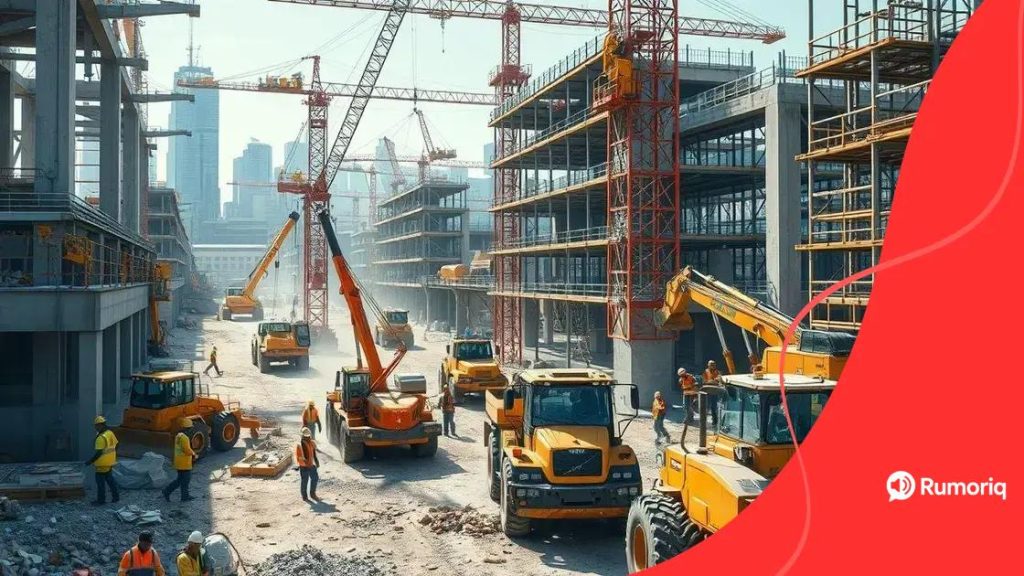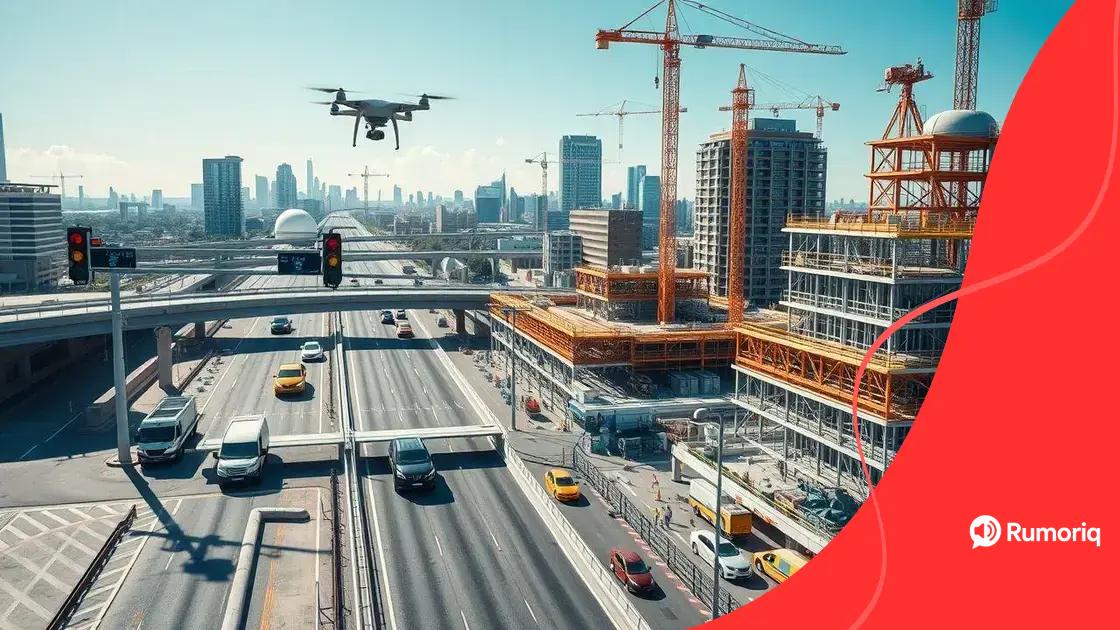US infrastructure projects update: what you need to know

Anúncios
US infrastructure projects are being transformed through emerging technologies, sustainable practices, and enhanced community involvement, focusing on building smarter, safer, and more efficient urban environments.
US infrastructure projects update is essential for understanding how recent developments can shape your community. Curious about how these updates affect you? Let’s dive in!
Anúncios
Recent changes to infrastructure policies
Recently, significant changes to infrastructure policies have been implemented across the United States. These updates aim to enhance public works, improve safety, and boost community resilience. Understanding these changes can help you see how they may affect your daily life.
Funding Allocations
The new policies focus on increasing funding for various infrastructure projects. This includes roads, bridges, and public transit systems. Here are some key areas receiving attention:
- Expansion of mass transit options.
- Repair and maintenance of aging bridges.
- Improvements to road safety measures.
These changes are designed to address long-standing issues that communities have faced for years. For example, many cities have struggled with traffic congestion. New funding can provide solutions that make commutes quicker and safer.
Anúncios
Environmental Considerations
An essential aspect of the updated policies is the emphasis on environmental sustainability. Projects now require environmental reviews that ensure they meet green standards. As a result, many infrastructure projects are now designed to:
- Reduce carbon emissions.
- Incorporate green spaces.
- Use sustainable materials.
These measures not only help the environment but also enhance the quality of life for residents. Communities can enjoy parks and greenways that promote outdoor activities.
Additionally, the policies encourage public engagement. Citizens are now invited to participate in planning meetings. This input is crucial for creating infrastructure that truly meets the needs of the community. When residents voice their opinions, it can lead to more effective outcomes and improvements that reflect their priorities.
As we move forward, the importance of staying informed about infrastructure policies cannot be overstated. By understanding the recent changes, you can better navigate the evolving landscape of public works and advocate for projects that matter to you.
Impact of funding on new projects
The impact of funding on new infrastructure projects is profound and multifaceted. When funds are allocated efficiently, they can drastically enhance the quality and scope of public works. Increased funding allows for the expansion and improvement of essential services, making communities safer and more accessible for everyone.
Types of Funding Sources
Infrastructure projects often rely on various funding sources. Understanding these can shed light on their implications:
- Federal grants tailored for specific projects.
- State budgets earmarked for local infrastructure improvements.
- Private sector investments that bring innovation.
These funding sources are crucial. For instance, federal grants often address public transportation needs, while local budgets might focus on community roads or parks. When combined, these efforts can maximize benefits for a broad range of projects.
Benefits of Increased Funding
More funding translates into numerous advantages. Higher investments often lead to:
- Faster project completion and reduced delays.
- Enhanced safety measures and infrastructure durability.
- Improved technology integration within projects.
Furthermore, increased funding encourages the use of modern construction practices that prioritize sustainability. This way, infrastructure projects are not only efficient but also environmentally friendly.
Additionally, proper funding empowers local communities to decide on the projects they need most. This engagement ensures that resources are directed toward the most pressing issues, benefiting more people in the long run. After all, when communities are actively involved in the decision-making process, the likelihood of successful implementations increases significantly.
Emerging technologies in US infrastructure

The landscape of US infrastructure is evolving rapidly, thanks to emerging technologies. These innovations are not only improving efficiency but also creating safer and more sustainable systems. It’s exciting to explore how technology is reshaping infrastructure projects across the country.
Smart Infrastructure Systems
One of the most notable advancements is the integration of smart technology into public works. This includes:
- Intelligent transportation systems that optimize traffic flow.
- Smart grids that allow for better energy distribution.
- Real-time monitoring systems for infrastructure health.
These technologies help cities respond quickly to problems and reduce maintenance costs. By using data-driven insights, urban planners can make informed decisions to enhance infrastructure.
Innovative Construction Techniques
New construction methods are also making waves. Techniques like 3D printing and modular construction are gaining popularity. They offer several advantages:
- Faster project completion times.
- Reduced material waste and costs.
- Greater design flexibility and customization.
These methods help meet rising demands while maintaining high standards of safety and quality. For instance, 3D printing can create components on-site, minimizing transportation and delays.
Moreover, advancements like drone technology and building information modeling (BIM) are changing how projects are managed. Drones provide aerial views for site assessments, while BIM allows for detailed planning and collaboration among teams. This leads to fewer errors and smoother workflows.
As these technologies continue to develop, they promise to transform the future of US infrastructure. Staying informed about these advancements is essential for understanding how they will shape our cities and lives in the coming years.
Environmental considerations in project planning
When it comes to infrastructure development, environmental considerations play a crucial role in project planning. These factors ensure that construction practices are sustainable and resources are used wisely. In recent years, the focus on environmental impact has grown significantly, making it a priority for planners and developers alike.
Impact Assessments
Performing environmental impact assessments (EIAs) is now common practice before starting any major project. EIAs help identify potential effects on:
- Local wildlife and habitats.
- Air and water quality.
- Climate change implications.
By understanding these impacts, planners can implement strategies to mitigate adverse effects. This proactive approach leads to more responsible development and minimizes harm to the environment.
Sustainable Design Practices
Another important aspect is the use of sustainable design practices. This means using materials and methods that reduce environmental footprints. For example:
- Incorporating renewable energy sources like solar panels.
- Utilizing recycled materials in construction.
- Designing green buildings that optimize energy efficiency.
These practices contribute to a healthier planet and help save on long-term operational costs. As communities embrace sustainability, they also enhance their resilience against climate change.
Moreover, engaging local communities in the planning process allows for better consideration of local ecosystems and cultural aspects. When residents participate, they often provide valuable insights into the natural environment, which can lead to better project outcomes. This collaboration fosters a sense of ownership and responsibility among citizens for protecting their local surroundings.
As we continue to prioritize environmental considerations in infrastructure projects, we pave the way for a future where development and nature coexist harmoniously. Understanding the importance of these factors will ensure that cities and towns grow sustainably.
Future trends in infrastructure development
The future of infrastructure development in the US promises exciting changes driven by innovation and sustainability. As we look ahead, several key trends are shaping how projects are planned, funded, and executed.
Digital Twins and Simulation Technologies
One major trend is the use of digital twins, which are virtual replicas of physical infrastructure. This technology allows engineers to simulate and analyze how structures will perform over time. Some benefits include:
- Improved maintenance planning through predictive analytics.
- Enhanced design validation before construction begins.
- Cost savings by identifying issues early in the design phase.
As technology evolves, digital twins will become a standard practice in infrastructure development, allowing for smarter and more efficient projects.
Green Infrastructure Solutions
Another significant trend is the shift toward green infrastructure solutions. Planners are prioritizing designs that enhance environmental resilience. Examples of this include:
- Rain gardens that manage stormwater effectively.
- Permeable pavements that reduce runoff.
- Vegetated roofs that improve air quality.
These solutions not only protect the environment but also contribute to community well-being. By incorporating natural elements, cities can reduce air pollution and improve urban biodiversity.
Furthermore, technology like artificial intelligence and machine learning is increasingly integrated into infrastructure projects. These tools help optimize processes, making them faster and more efficient. For instance, AI can analyze traffic patterns to inform transportation projects, ensuring they meet the evolving needs of urban areas.
As we consider these future trends, it is clear that collaboration and innovation will be key. Engaging communities in the planning process ensures that infrastructure meets their specific needs and preferences. An inclusive approach will lead to projects that benefit all citizens and foster sustainable growth.
FAQ – Frequently Asked Questions about US Infrastructure Development
What are the main benefits of integrating technology into infrastructure projects?
Integrating technology can improve efficiency, reduce costs, and enhance safety in infrastructure projects, leading to better outcomes for communities.
How is sustainability prioritized in future infrastructure development?
Sustainability is prioritized through the use of green materials, eco-friendly designs, and practices that minimize environmental impact during construction.
What role does community involvement play in infrastructure planning?
Community involvement ensures that infrastructure projects meet the specific needs of residents, fostering a sense of ownership and responsibility for local development.
What are digital twins and how do they benefit infrastructure projects?
Digital twins are virtual models of physical structures that allow for better planning and maintenance by simulating how assets will perform over time.